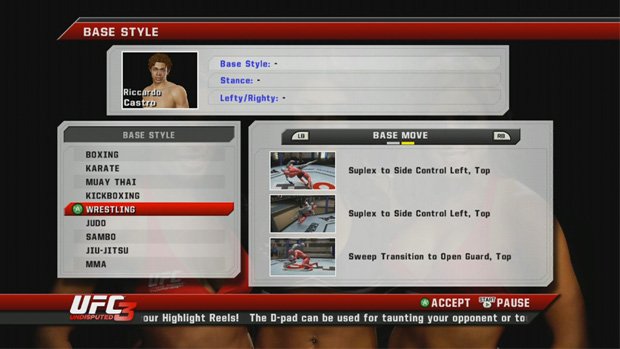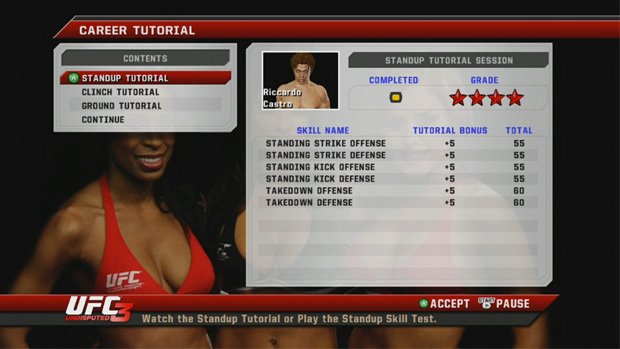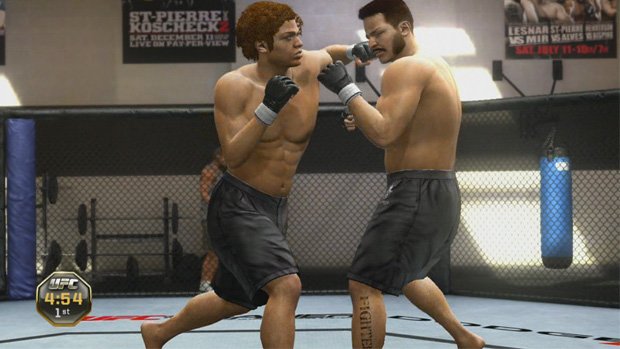UFC Undisputed 3 career mode guide
Go from being a nobody to a somebody with our career guide
Getting Started
When starting a career, you have to options. You can choose to create a fighter completely from scratch, or take one of the real life fighters in either the UFC or Pride through a whole new career. Any of the UFC or Pride fighters will being a career at the age of 20, no matter how old they are in real life. If you decide to create your own fighter, you can have them be any age you want. There’s no particular benefit or detriment to either of the options, so you can’t go wrong picking either of the choices.

The first step is figuring out which of the game’s seven weight classes you want to fight in. There are four categories of attributes for every fighter: Strength, Speed, Cardio, and Footwork. Each attribute is based on a 100-point scale, and the seven weight classes have varying maximum ratings a player can achieve. Bantamweights have low-rated (85) strength and cardio, but have maxed out (100) speed and footwork. The opposite is true of heavyweights, who have maxed out strength and cardio, but low-rated speed and footwork. The other five classes all fall somewhere in between, so it’s really a matter of preference what division you want to fight in.
After picking a weight class and then creating your fighter (or choosing a UFC roster fighter), you’ll move on to picking a fight style. Even if you do choose a pre-existing fighter, you get to choose what style of fighter they’ll be. There are nine base styles to pick from: Boxing, Karate, Muay Thai, Kickboxing, Wrestling, Judo, Sambo, Jiu-Jitsu, and MMA. Eight of the styles come pre-loaded with some technique moves, while the MMA style allows you to pick a few special moves to give your fighter.
All nine of the styles also influence your starting statistics. Boxing starts you out with slightly higher striking. Karate starts out with slightly higher kicking. Wrestling starts you out with slightly higher takedowns. And so on. Each of the styles certainly has its benefits, but the MMA style does start you out with the lowest possible stats of all the available choices. That, coupled with the fact that all eight other styles come pre-loaded with several special techniques right off the bat, means it’s best to look elsewhere when just starting out a career for the first time.
Once you’ve decided on a style, you’ll choose fighting stance (orthodox, southpaw, or both), and a favored hand. From there, it’s off to the tutorials section. There are three tutorials to go through, each testing your acumen in either standup, the clinch, or the ground game. Each of the tutorials is rather simple. All you have to do is watch a short tutorial (which you can skip if you already played through the game’s general tutorial), and then participate in one-round sparring session to test your aptitude in that particular skill set. A meter on the bottom of the screen fills up based on your performance, and the better you do, the faster it will fill. The meter will only increase when you do things related to the skill you’re being tested on.

If you’re in the standup test, you should only be throwing punches and kicks. Engaging takedowns or clinching will not earn you any points there. The clinch test will only award you points if you engage your sparring partner in the clinch, and then attack. Straight punches and ground transitions will not earn you any points. Likewise, in the ground test, standing strikes and clinching will get you nowhere fast. It’s all about getting your opponent down to the mat, and then dealing out damage, and working on your transitions.
Test results are then graded on a five-star scale. Successfully earning a five-star rating will give you a five-point bonus in all related statistics. Gaining less than five stars will also get you a bonus, but it will be much smaller. A five-point instant upgrade is huge when just starting out your career. You only have to complete these tests once no matter how many careers you start. Since you can take the tests as many times as you want before continuing, it’s to your advantage to make sure you earn the highest maximum bonus before advancing to the next step.
From the skill tests, you’ll advance to a one-round sparring session with the computer that will judge your abilities, and then suggest a difficulty rating for your career. This is your first chance to put all of your combined knowledge to the test, though it should be noted that you won’t be automatically assigned a difficulty based on your performance. Though the game is judging your skills, it merely advises you set the difficulty to a particular setting. Once you do start your career, that difficulty will be locked in for the duration, so you’ll want to pick an option that offers a challenge without being completely frustrating when you advance to more challenging computer opponents.

You’ll also be asked to pick an energy setting before officially starting your career. Default is a bit more arcade-like energy. Fighters will get tired, but not very quickly. You’ll be able to throw more heavy punches and kicks, and working the ground game won’t tire you out as quickly. Simulation is a much more realistic energy setting. Fighters will get gassed after throwing a few stronger strikes, and constantly trying for transitions will cause you to tire out faster. If this is your first time playing a game in the Undisputed series, you may want to stick to the default energy setting. Though it should be noted, once you choose, that’s the setting that you’ll be using for the length of your career.
Sign up to the GamesRadar+ Newsletter
Weekly digests, tales from the communities you love, and more


